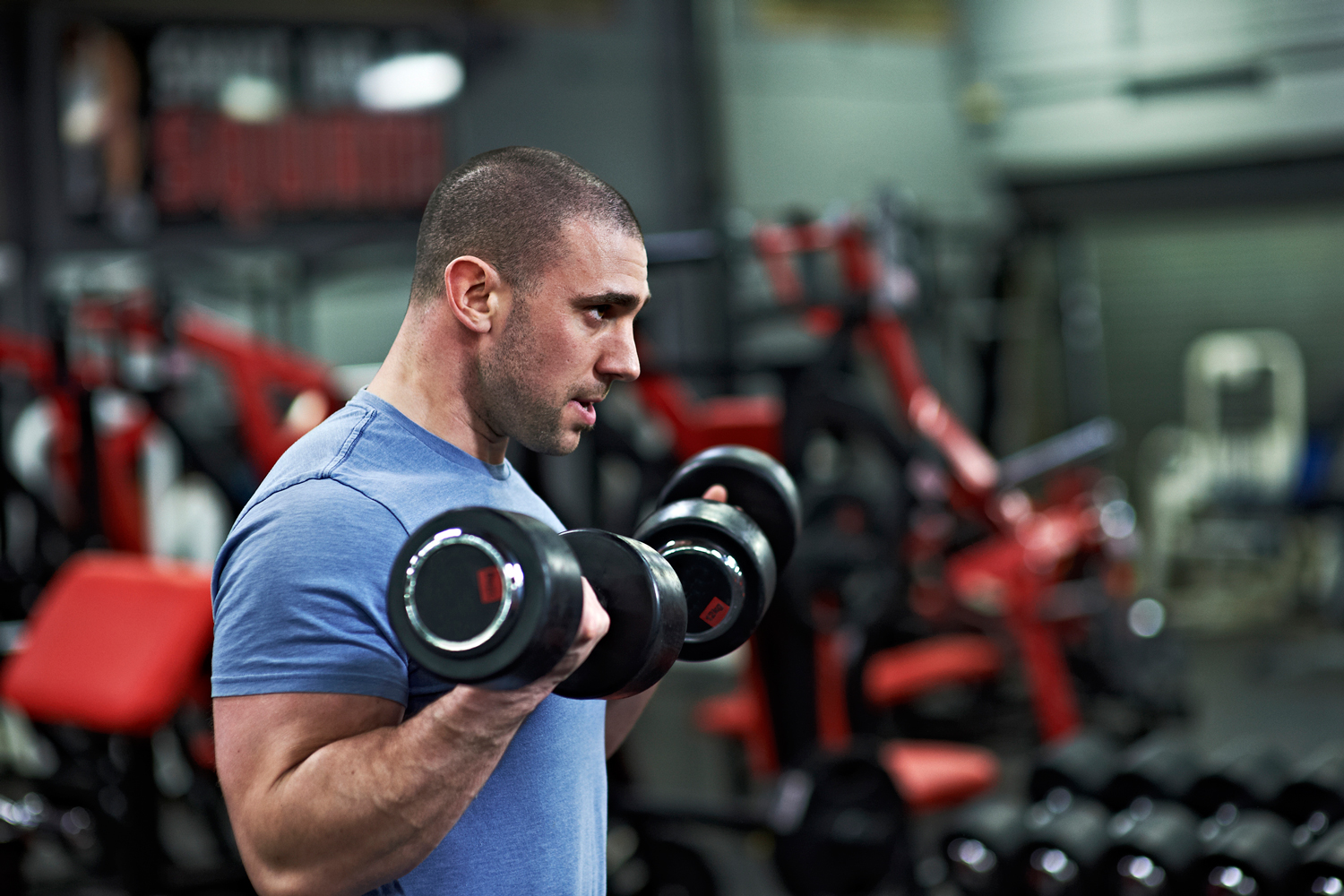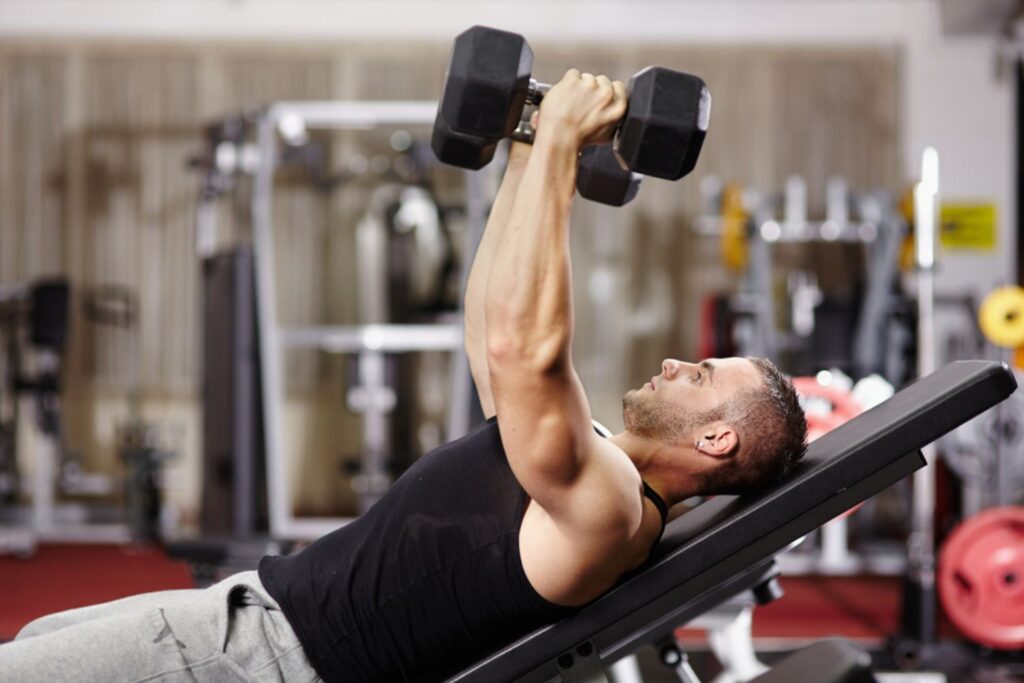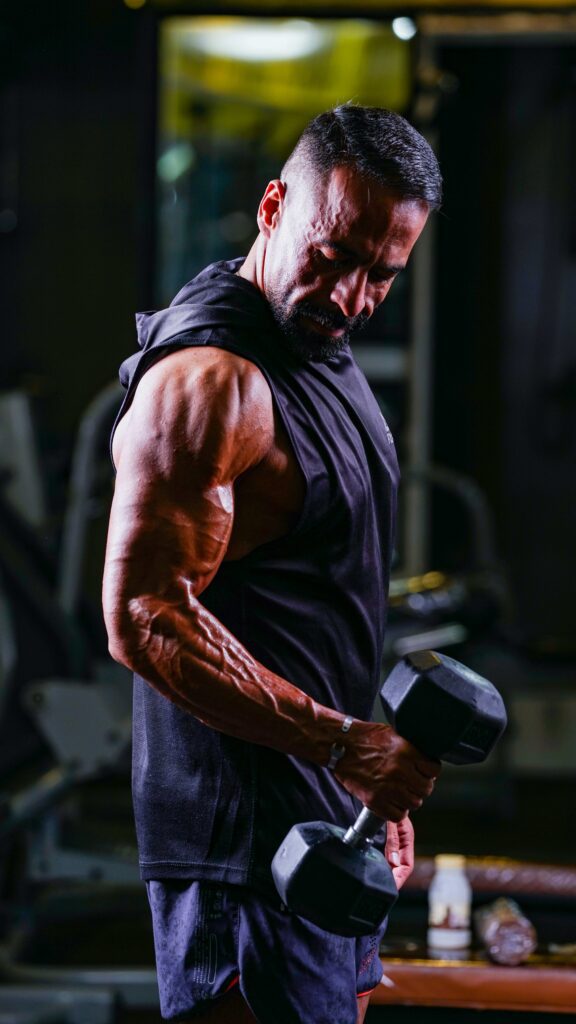YOU CAN CONSTRUCT a workout plan using overly-involved gym set-ups, fancy, high-tech tools and machines, and complicated exercises, but no matter how much effort you put into the window dressing, the simplest way to build big arms will be to do exercises like dumbbell biceps curls.
This is a gold standard of isolation exercises and the go-to muscle move for just about anyone who’s ever hoisted a dumbbell. Whether you’re standing in front of a mirror at a dumbbell rack, running through reps, or sweating through a home workout with a pair of adjustable weights, the biceps curl will fit into your workout routine. There’s something elemental about the movement—who hasn’t flexed in front of their bathroom mirror?
The dumbbell biceps curl’s simplicity makes it an excellent fit for almost all types of exercisers—but that also means that sometimes, guys don’t stay focused on the finer points of proper form. There’s more to the movement than just cranking the weights up to shoulder height and dropping back down.
Let Men’s Health fitness director Ebenezer Samuel, C.S.C.S., guide you through the dumbbell biceps curl’s subtleties, saving you from the bad habits that are keeping you from unlocking your big arm potential.
Benefits of the dumbbell biceps curl
The main aim of the dumbbell biceps curl is to build muscle. This is an isolation exercise, which means that you’re focusing on one specific muscle (in this case, unsurprisingly given the name, the biceps). This also means that you can use a high volume of reps to target the muscle, since you won’t be fatiguing as early as you might when performing heavyweight compound exercises. You won’t be able to work as heavy as those movements, but that’s okay.
You’ll also work through the two main functions of the biceps: elbow flexion (bending your arms) and supination (rotating your forearms). When you use proper form, you’ll do both, stimulating muscle growth and flooding the muscle with blood for a pump.
Which muscles the dumbbell biceps curl targets
You won’t be shocked to know that you’re going after the biceps when you perform this exercise—it’s right there in the name, after all. Since this is an isolation movement, your aim will be to keep the focus squarely on these muscles and not compensating with a hip swing or shifting your shoulders to help with the load.
That’s not to say that there are zero secondary beneficiaries of the curl. If you’re strict with your form, you’ll also hit your forearm muscles when you grip the handles of the dumbbells with intent.
How to do the dumbbell biceps curl
- Stand with your feet hip-width apart, holding a pair of dumbbells in a neutral grip (palms facing each other). Squeeze your shoulder blades, abs, and glutes to create full-body tension.
- Curl the dumbbell up, moving only at the elbow joint. Keep your upper arms still and perpendicular to the floor.
- As you curl up, rotate the dumbbell inward so that your palm faces the sky. The weight should be parallel to the floor by the time you reach the halfway point.
- Continue raising the weight up, squeezing the biceps at the top of the movement.
- Lower the weight back down with control.
Use this extra insight from Samuel to inform your reps.

Stand straight
Eb says: Be aware of your posture. It’s one of the prime things people neglect on a curl. You want to squeeze your shoulder blades, squeeze your glutes, and and contract your abs. Keeping your scapulae retracted and depressed is critical in the long term; it’ll can help you avoid any impingement issues.
Keep your shoulders out of It
Eb says: Focus on keeping your upper arm perpendicular to the ground at all times. You’ll see a lot of guys getting their shoulders involved in a curl, rocking their elbows forward. That allows the shoulder to get involved in the movement. By working to keep your upper arms perpendicular to the ground, you force all the movement to occur at the elbow joint. One of the chief functions of the biceps is to flex at the elbow.”
Stay in rotation
Eb says: Make sure to rotate that weight early. The oft-forgotten function of the biceps: rotating your forearm so your pinky is toward the sky. To truly and effectively train the biceps, you’ll want to curl the weight upwards and rotate the dumbbell upwards. Start that rotation early, before your forearm is parallel to the ground. By doing that, you insure that you’re keeping the curl focused on your biceps and not the brachialis. And keep attacking that rotation for the life of the curl: You should finish each curl by twisting as aggressively as you can at the very top.
How to add the dumbbell biceps curl to your workouts
This is a gold-standard movement that you can add to all kinds of workouts. Curls are key movements for any upper body or pull day splits, and if you train with a split that focuses on one body part or muscle group per day, you’ll do curls when you hit arms.
Since you won’t be using super heavy weights, you can program the dumbbell biceps curl at the back end of your workouts, after the heavier compound movements. To add more volume, consider supersets with a triceps exercise or drop sets.
If you’re simply getting a pump on, that’s fine too. Samuel suggests training with the dumbbell biceps curl twice a week for three sets of 12 reps.
This story originally appeared on Men’s Health U.S
Related Articles:
















